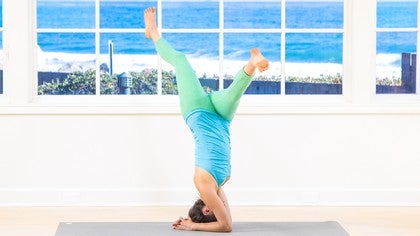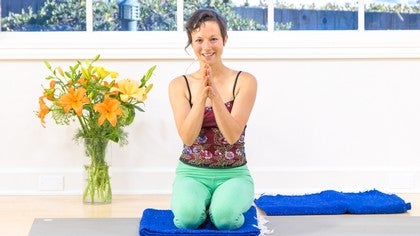Description
About This Video
Transcript
Read Full Transcript
(ocean waves sloshing) Hi, so I wanted to outline a few key points for the sirsasana, or headstand, practice. Of course there are a few contra indications for going up into a longer headstand but if you have some of those, I bet you're not thinking about going into a 15 minute headstand anyways. High blood pressure, glaucoma, a few of those other things. Pregnancy, some people say that going into a longer inversion during pregnancy could potentially move the baby or put stress on the mama. I did a headstand practice up to 10 minutes until I was seven months pregnant and it felt great for me so it's really up to you and your medical professional.
Another thing to be careful with is scoliosis. So I have a little scoliosis which you might see in the longer headstand practice. In fact a lot of us have that little asymmetry. It's okay, we are imperfect beings but if there is any feeling in the spine that's sharp or anything like that or there's a contraction of one side more than the other and it starts to seize up a little bit, definitely come out. We do not want to perpetuate any tightness.
Even if we have a little imbalance is fine. We can actually ease around that imbalance and work evenness of tone around that imbalance and we can stay in the inversion but it's really a personal journey with you to know when that kind of stuff is happening and sometimes it takes going up into a headstand and trying it for a few times and then when you come out of it, really noticing how you feel maybe the day after noticing how you feel in your neck, in your cervical spine, in your shoulders. If anything tends to seize up or come out of balance. So let's interlock our hands and take them over our head and I just want to show you that when I do this without back bending, my upper arm bone is long enough that comes over top of my skull. So that is a good thing because if I can maintain pressure into my arms, it will take some of the pressure off of the skull.
Some people who think they don't have that length, they might actually have it with a little bit of work at lengthening the side body muscles and these big lap muscles and some of the small muscles that lie underneath that come into the outer shoulder, even the deltoid, this whole area here. I wanna show you a way to start to lengthen those out. You can come down like this. You've probably seen this before as well but let's get into it. Take the outer elbows, interlock the fingers loosely in front, and press down through the ulnar point of your pinky finger, let your head hang, fill up the space between your shoulder blades, and come into a downward dog.
Head is off of the floor here and I'm thinking about from the elbow point there's a strong pressure all the way to the ulnar wrist point. The whole form is pressing into the floor. I'm lengthening back. I don't want to jam my shoulders into the floor in a back bend. In fact I want to lift my armpits and get more length and I also don't want to unplug my shoulders completely in an effort to get too much length so the inner shoulder blade stays down the back and the outer shoulder blade lengthens so you might stay here for ten breaths, come into child's pose, and repeat.
This is a wonderful posture. If you have the length in the humerus bone, and you can actually have your head off of the floor in a headstand, if you have cervical stuff going on and you don't want to put your head on the floor, you can actually go up to a wall and enjoy a headstand practice with your head off but your forearms down but you do need to have length to be able to do that. Because of that little scoliosis I was talking about, that little asymmetry where one ribcage is a little bit more depressed than the other, I always use a mirror in the sirsasana practice, and it has to be a big enough mirror for me to see from the base to about my hip bones, and maybe just the top of my thigh bone and I can make these little adjustments to work around my central axis. Also if i feel like there's a little compression then I can make a movement and it's so helpful to have that feedback in the mirror of those little counterbalances around the axis. In the headstand practice that I'm doing I will be using a mirror and I recommend that you use one at home.
I know a lot of yogis have resistance to use a mirror because it doesn't always bring out the best in us. There can be something superficial that comes out when you look at yourself in a mirror in your practice and maybe it takes you out a little bit but hopefully it can be a tool and I think over time that stuff starts to soften a little bit and you can use it as an alignment tool without getting stuck in the form because there's so much behind that. I think about my son when he sees himself in a mirror and he's always overjoyed. He's in love with himself when he sees him in a mirror. He's like "somebody to play with." he thinks he's so beautiful and it's beautiful.
Enough on the mirror. So I want you to interlock your hands and place them on the crown of your head. If you're gonna do a long headstand practice and you're fairly healthy in this area, in the cervical spine, it's helpful to use your arms but then part of the weight is going to have to come onto your skull and that's actually not a bad thing because if you press your skull into your hands like this and try not to press with your chin up or down, find that place where you feel pretty even as you press all the muscles around your neck kind of light up a little bit and you really want all the muscles, especially the deeper muscles to work a little bit. So if you didn't do that, that would happen in your headstand and that feels horrible. So it is a press.
As you take longer headstand practices you might feel that there is a place in the center of the skull that you really want to press into. If you can imagine, there's two hemispheres in your brain. Right between those hemispheres is this mo hawk connective tissue. That's called the falx, and that, if you can imagine right in the center sticking up, is where you want to press your head into the floor. You don't want to be too close to the hairline and you don't want to be too close to the crown.
You actually want to be on that soft spot in babies, the fontanelle, and for some people, it might be more toward the hairline than the crown. So let's see if we're using our neck and see if it feels okay in a little variation. So that same thing, the clasp, and I actually use a loose clasp like this in the headstand. The reason that I do that, and I learned that from one of my teachers, Joy Irwin, is that if I was gonna fall backwards, I grip my fingers and my fingers stop me from going backwards. It's just like in a handstand, your fingers are always moving and counterbalancing and your fingers will grip to stop you from going over into a back bend.
In a longer headstand that's really helpful and I like the way it feels. I'm really karate chopping that ulnar wrist point down. The forearm bones are pressing down and one of the forearm bones bows so if you press down pretty firmly there, it's right in the center. It doesn't knock you over in its bow so it's important to be strong there. Then we're gonna take our head right in between the wrists and make sure in both eyes you can see your elbows and it's varying for people, the placement, but mine are pretty close.
I like them pretty close. Then I'm gonna come up into a downward facing dog and walk my feet in so I feel like I start to place more pressure onto my head. This is really not a good idea, to slump your shoulders around your neck like this so the shoulder blades lift up with the press of the forearms and the outer wrist point. So enough weight in my feet here to keep pressurizing the center point of my skull down, feeling the neck muscles fire up, and then I'm going to let one hand go and place the back of the hand on the mat and if I feel okay, I'm going to let the other hand go and place the back of the hand on the mat. As I press down into my hands I lift my shoulders away from my ears and I just feel my neck and I maintain this pressure.
I imagine I have that mo hawk moving into the floor like a razor blade. I press it, and then I soften the press so it's not too much, but there's length. Then I'm gonna come back and that's when I would go up. So just check out how that feels. Come down into a child's pose, roll around, and come up.
The first time you do this, your sirsasana practice. If you don't have a longer headstand practice, I would come out as soon as you feel anything questionable. Then just do it over and over again and see if you can expand your range in a really relaxed way. But it's one of my favorite practices, headstand shoulderstand (laughs). Thank you.
Grounded Joy
Comments
You need to be a subscriber to post a comment.
Please Log In or Create an Account to start your free trial.











